Does Wireless Mic NPRM Set a Record for Number of Questions?
Let me count the ways:
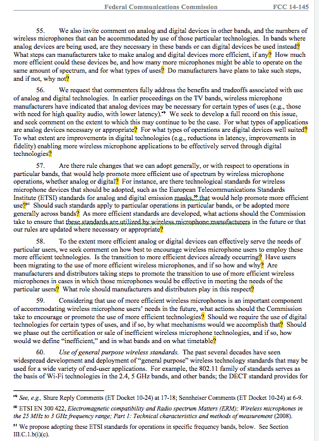
Above is a typical page with all the questions ending in question marks highlighted. There are 314 such questions and they appear on 49 different pages! Is that all? Of course not! The multiple authors of this document are very creative in making and hiding questions to make an exact count difficult. The word "seek" appears 158 times in such uses as
- "Further, we seek comment on proposals for authorizing wireless microphone operations in additional spectrum bands, consistent with the Commission’s overall spectrum management goals_ - para. 4
- "In addition, we seek comment on authorizing licensed wireless microphone operations in other bands. " - para. 30
- "We seek on comment on the different groups of wireless microphone operators and their various uses of microphones, including the particular applications served by the microphones, the types and number of devices used, the extent to which the devices are analog or digital, the settings in which they are used, and the frequency bands they use. " - para. 33
- "We also seek comment on the nature of the demand for wireless microphones by various wireless microphone users" - para. 38
Arguably some of the uses of "seek" in the text are not actually questions, so the count of 158 is a little high. But FCC staff has ways of asking questions without either the use of a question mark or the work "seek":
- "We ask that the different user groups, or the manufacturers of products for these groups, provide detailed information about the particular nature of wireless microphone uses by different groups of users." - para. 33
Your blogger actually compiled and submitted a list of all the 176 questions in Docket 14-177 (24+GHz 5G), but he does not have the patience to do the same in this tangled mess. As we have indicated in the posts mentioned earlier, both UK's Ofcom and Industry Canada number questions in their NOI and NPRM counterparts. Now some would say that they are not subject to the APA like FCC is, but having attended the FCBA reception at the Supreme Court last night, let me boldly say that I don't think the Supreme Court would remand an FCC decision just because its questions had numbers. It might remand a decision because it did not address the record and with so many tangled questions, how does one address the record?
TPRC Paper on FCC Spectrum Policy Throughput

On Thursday 9/17 TRDaily, a prominent communications policy newsletter, published an article about your blogger's paper for next weekend's 2015 TPRC | 43rd Research Conference on Communications, Information and Internet Policy (formerly Telecommunications Policy Research Conference). The previous link goes to the paper that can be downloaded for free.
The paper does not criticize any specific FCC decisions, rather it is concerned about the speed and transparency of such decisions. The concerns raised in the paper are not due to any one chairman or one party, rather they are issues that have developed in the past 20-30 years under multiple leaders.
Here is the abstract:
Today’s FCC is not as well structured to handle the reality of its spectrum policy workload as the early Commission was and may not be even keeping up with workload. Indeed, there is increasing evidence that “triage” is a key issue in spectrum policy. That is the nontransparent decision to even address an issue is a major determinant of its outcome. This could be both deterring capital formation for new spectrum technology R&D as well as creating real risks for incumbent licensees since emerging interference issues that need rulemaking or nonroutine action are not getting resolved in a timely way.
In 1934, the new FCC took a page from the structure of the ICC, one of its predecessors, and divided the then 7 commissioners into 3 “divisions” that could operate independently in the police areas of telephone, telegraph, and radio. There was no Administrative Procedures Act (“APA”) so rule deliberations were far simpler than today. The maximum frequency in routine use was 2 MHz and the modulation choices were just AM and radiotelegraphy. In the early days, a few of the commissioners had technical experience in spectrum issues.
Today we have the APA and nearly 70 years of court decisions than make rulemaking much more complicated. We have 5 commissioners that only make decisions en banc with virtually no §5(c) delegation to staff on emerging issues. Allocations go to 275 GHz, but service rules have been stuck at a 95 GHz limit since 2003. The selection process for commissioners appears to be focused on nonspectrum and nontechnical issues.
The result of all these factors is long drawn out deliberations on both new technology issues and on resolution of merging interference issues. While the US’ economic competitor nations often use “state capitalism” as a key issue in spectrum policy by subsidizing chosen new technologies and then cooperating to remove national and international spectrum policy limits for them, US entities in spectrum R&D often face both a lack of funding and an indifferent FCC (as well as NTIA - if access to G or G/NG spectrum is at issue).
The paper looks at a variety of spectrum policy issues FCC had dealt with since 2000 and examine the delays involved and their impacts. The issues consider include new technology issues such as the TV White Space, the FWCC 43 GHz petition and the Battelle 105 GHz petition as well as emerging interference issues such as police radar detector/VSAT interference, cellular booster-related interference, and FM broadcast/700 MHz LTE interference. The time lines of such deliberations will be reviewed as well as the likely impact of these timelines on the business plans of FCC regulatees.
Finally possible options to improve FCC throughput that are both feasible within existing legislation and consider approaches successfully used in foreign spectrum regulators will be discussed.
FCC Excellence in Engineering Awards:
Well Publicized for the First Time!
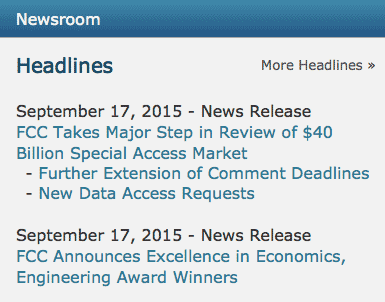
The above headline appeared on the FCC home page yesterday. This was the first time that FCC has given such attention to the near annual Excellence in Engineering Awards that started in the Powell Chairmanship. As we have written previously, these awards have been a mystery — perhaps almost an embarrassment to the FCC where commissioners regularly lavish public praise on interns who have been around for just a few months - even minutes after voting to terminate the jobs of dozens of FCC field employees.
In past years there has usually been more than one award, but this year the only award was:
Mark Colombo and Barbara Pavon of the Office of Engineering and Technology and Sasha Javidof the Wireless Telecommunications Bureau are the winners of the 2015 EIE Award for theirwork on development of the analytical tools and software that are the engine “under the hood”powering the TV incentive auction.
Our congratulations to Mr. Colombo, Ms. Pavon, and Mr. Javid for their excellent work and this public recognition. Let's hope that such excellence in engineering work at FCC continues and that FCC continues to recognize it publicly!
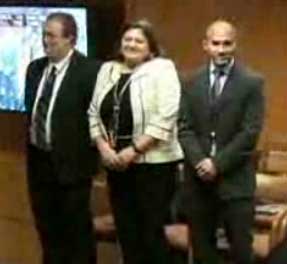
The awards are at 36:53 in the video of the Commission meeting
A Top FCC Officals Mentions "Drone"!
Hello, Reno! Look forward to talking fiber, wireless, drones, startups in the Biggest Little City in the World. pic.twitter.com/kcx0OR9DU1
— Ajit Pai (@AjitPaiFCC) September 11, 2015
- A July 1, 2010 letter from Chmn. Genachowski to Rep. Waxman mention drones several times, but all in the context of questions on whether AWS-3 spectrum transfers would affect DoD's use of drones in CONUS.
- A March 13, 2014 speech by Comm. Clyburn mentions that the then pending "Drone Aircraft Privacy and Transparency Act would limit the use of drones in U.S. airspace". This bill from Rep. Markey has not passed the House.
- The April 27, 2015 Report and Order in ET Docket No. 12-338 states that in the 4400-4940 MHz band "Typical Federal uses include, but are not limited to, point-to-point microwave, drone vehicle control, and telemetry" and makes no mention of civil drones.
- Comm. O'Rielly's April 28, 2015 PCIA speech mentions possible new types of cellular infrastructure says "Some people have suggested such ideas as a series of balloons, solar-powered drones, or small satellites."
It is frankly puzzling given how much discussion there is everywhere in DC about drones that FCC has so little interest in the topic.
Drones need airspace, regulated by FAA. Drones also need spectrum, regulated by FCC.
Drones compete for that spectrum with other incumbent of future users.
Some drone use of spectrum may be too burdensome for other users.
Some bands may be perfectly appropriate for drones use.
How is this ever going to be resolved considering FCC's apathy for this topic?
UPDATE
Comm. Pai apparently is on a roll with the drone issue as his 8th Floor colleagues and the FCC staff continue their deafening silence that drones on.
Perhaps this is confirmation of your blogger's hypothesis that there is a real throughput shortfall in FCC's present process and resources for resolving spectrum policy issues and, like Donald Trump, the incentive auction has "sucked all the oxygen out of the room".
The September 17th tweet below is his second public mention of "drone" in less than a week, setting a new record for any FCC official! Perhaps he didn't get the memo that any FCC mention of this topic is forbidden?
Now can one of the FCC commissioners take a similar interest in millimeter wave technology and FCC's apparent "War on Millimeterwaves"?
Grateful to @unevadareno UAV team for stimulating discussion re technology/regulation of drones. Much to think about. pic.twitter.com/pOvxIlvKEb
— Ajit Pai (@AjitPaiFCC) September 17, 2015Europe and Japan March Ahead in Millimeterwaves with their State Capitalism Spectrum Model While FCC Hesitates

We have previously written about the FCC's "War on Millimeterwaves" - the inaction on moving the upper end of spectrum regulation above 95 GHz where it has been since 2003. Why invest in such new technology when you have no idea when FCC will allow market access? There are lots of other new technologies out there, some FCC regulated and others with different types of regulation, where either no government approvals are needed for new technology or where the needed approvals are both timely and transparent. Unless you are a masochist, why limit yourself to FCC-regulated technology and certainly why invest in a technology where there is "no light at the end of the tunnel". FCC's "blind eye" to the statutory requirements of Section 7 of the Communications Act to act in a timely way on "new technology" isn't helping either.
So let's look at what our national economic competitors are doing. The new report shown at the top of this page is from ETSI, the European Telecommunications Standards Institute. While this might sound like ANSI, its US counterpart, ETSI is really very different in that Europe's telecom regulators are key members and CEPT, the organization of Europe's "FCC's" had a key role in starting it. Also note that in Europe national and EU regulations often permit the use of equipment meeting ETSI standards, e.g. GSM and DECT, and forbid alternative technologies such as those developed and sold in the US.
In this document Europe Inc is making a roadmap for millimeter wave technology and it is clear that the same Europe Inc. is subsidizing the R&D of this technology. Here is part of the discussion of what this technology can be used for:
A variety of wireline as well as wireless technologies are available to build transmission infrastructures and usually a mixed environment of physical media is adopted. While optical fibre is perceived as the physical medium with the top performance, there are techno-economic factors that make installation or even extension of optical fibre network not always the most appropriate solution. Hence, wireless technologies represent today a significant or even a dominant percentage of various operators' transmission networks to serve efficiently the increasing upward trend for providing data-hungry applications.
While microwave solutions at traditional bands are more or less employed by all kinds of service providers (mobile, fixed), it becomes clear that moving to millimetre wave frequency bands, where underutilized massive bandwidth is available, will assist to deliver transmission services of equal to optical fibre performance avoiding the constraints that the latter might impose at particular scenarios. In this sense, millimetre wave frequency bands can be used in an immense number of current and future high-speed wireless transmission applications.
While FCC Docket 14-177 deals with mobile applications above 24 GHz, the NOI seems to go out of its way to deal only with mobile uplinks and downlinks issues, even though now mobile systems will need lots of infrastructure and backbone, much of which is a target for mmWaves. In any case, while UK's Ofcom has been much faster than FCC on its counterpart of 14-177, the FCC next action is still a few months away.
This week we have news from Japan on Fujitsu's development of a new 300 GHz receiver, shown below:

Note this section from the linked Fujitsu news release:
A portion of these research results were obtained through "R&D Program on Multi-tens Gigabit Wireless Communication Technology at Subterahertz Frequencies," a research program commissioned by Japan's Ministry of Internal Affairs and Communications as part of its "Research and Development Project for Expansion of Radio Spectrum Resources."
Yes, Japan, Inc. is partially funding this R&D through the very same agency that is FCC's Japanese counterpart! Now do you think Fujitsu is losing sleep about regulatory delay when it is ready to market this technology?
Such state capitalism is not the US system and should not be the US system. But in highly regulated areas like spectrum how can US entities compete against Europe, Inc. or Japan, Inc.? The answer is increasing transparency of spectra policy as well as its timeliness.
Why is Qualcomm a US company? Qualcomm was incorporates in July 1985 a few months after the May 1985 Docket 81-413 decision that permitted general use of sported spectrum in 3 unlicensed bands. According to cofounder Viterbi this stimulated the capital formation needed to get things rolling and within 2 years Qualcomm got FCC approval for its CDMA cellular technology - unbelievably controversial at the time.
At the end of the Declaration of Independence are the words "we mutually pledge to each other our Lives, our Fortunes, and our sacred Honor.” Qualcomm founders Viterbi and Jacobs may not have pledged their "lives" to get the company founded, but they certainly pledged their "fortunes" and "sacred honor" as 2 major leaders of communications theory and technology at the time. But they were able to get timely and transparent treatment from FCC at that time and a major company now results that contributes to US leadership in telecom technology.
Let's face up to the reality of state capitalism in our economic competitors and see what can be done to "level the playing field". I think speed and transparency for new technology would be a good step. Who knows, maybe even FCC compliance with Section 7 of the Communications Act after these many years might be nice step?
Stingray: DOJ Reforms Its Rules While FCC Silence Continues Delegation of Authority Issues

Stingray is apparently a device develop by the Navy (hence the nautical name) and now used by federal and some local law enforcement agencies (apparently under strict rules from FBI) to track cell phone use. It has been granted FCC equipment authorization and one model has grant number NK73092523 (Search here for public details.) The device spoofs cellular base stations to force cell phone to transmit information and receives such information.
Today the Washington Post and Wall Street Journal both reported that the Department of Justice will be "adding more judicial and internal supervision to a practice that critics say invades privacy and has had too little oversight for years." However the new DOJ rules do not necessarily apply to state and local police departments according to WSJ.
There are 2 key FCC issues here:
- The FCC equipment authorization grant is somewhat questionable especially due to the extreme and probably illegal redaction of documents from the manufacturer in the FCC FOIA release. Note that this redaction included information in the public equipment authorization grant. Most likely the redaction was made by FBI and rubber stamped by FCC. (The good news: FBI understands FOIA somewhat better than FCC staff and at least the FOIA exemptions are clearly marked on this release, something FCC has, at best, been inconsistent about in other releases.)
- Use of such equipment by state and local law enforcement requires an FCC license or STA/waiver. Who at FCC approves such actions? and consent of cellular carriers. Has this been done?
- Use of such equipment by federal agencies also requires carrier consent and FCC/NTIA coordination. Who approves such actions?
Delegation of Authority Issues
In your blogger's paper at this month's TPRC conference he raises the issue of low FCC throughput on various spectrum policy issues, even ones favored by CTIA other than incentive auction. One root cause of this problem is probably the Commission's outdated delegations of authority under Section 5(c) of the Comm Act. Many truly noncontroversial items end up on the 8th Floor and getting delayed. These are both technical issues discussed in the TPRC paper and nontechnical ones such as this example raised by my former FCC colleague Randy May.
But many issues that would benefit from commissioner attention may not be seen by them under the present delegations. Comm. O'Reilly has voiced concern about "depriving commissioners of the right to vote". But maybe the issue is that the commissioners are voting on the wrong subset of issues, delaying obscure noncontroversial issues and not giving oversight to important issues like Stingray.
Your blogger has no view on the merits of Stingray use, but today's news from DOJ confirms that its initial use was not well thought out. Did the 5 presidential appointees at FCC add any value to this process? Were they even aware? Note that the Bush43 Administration abuses of illegal NSA surveillance of phone and Internet was - in you blogger's view - almost certainly explicitly condoned by someone in FCC. Were the 5 commissioners at that time aware of this? Did they have meaningful input?
Rationalizing and reforming the FCC's delegations of authority will both improve FCC productivity as well as help maintain the rule of law.
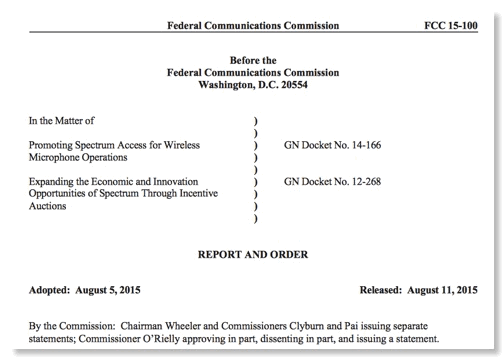
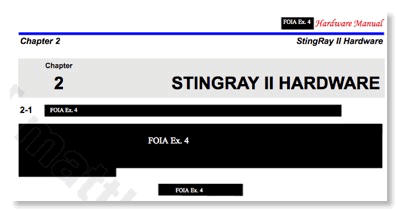



![Validate my RSS feed [Valid RSS]](valid-rss-rogers.png)

